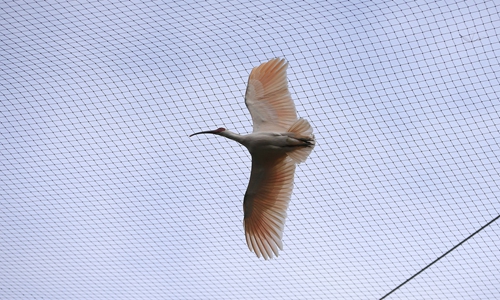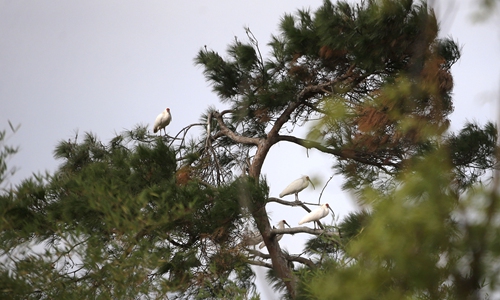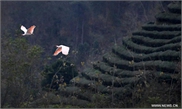China made a miracle in saving and protecting giant pandas from the verge of extinction, and now the miracle is repeated for the crested ibis, which is also known as an auspicious "fairy bird" or "beauty bird" in Asian culture.
The species is still endangered, but its revival is a conservation success in China, in which Qiu Guoqiang, an expert on the crested ibis, plays his role in East China's Zhejiang Province.
The crested ibis is believed to have existed for 60 million years and commonly settled in China, the Korean Peninsula, Japan and Russia until the 1960s. Bird conservationists attribute pesticides, fertilizers, hunting, environmental and ecological reasons for bringing the birds to the brink of extinction.
Since the crested ibis became extinct on the Korean Peninsula and in Russia in the 1970s, the last spotted six crested ibises in Japan were believed to be the last group of the species on earth, and the Japanese government decided to put them in captivity in 1981 for better protection. Yet the controversial practice turned out to be a failure, as the birds didn't survive. The last one died in 2003, signifying the extinction of the species in Japan.
A Chinese scientist, Liu Yinzeng, then a researcher at the Chinese Academy of Sciences (CAS), didn't accept that crested ibises were extinct in China. He led a team in 1978 to search for the bird throughout China.
The turning point occurred in May 1981 after Liu and his team had climbed over mountains in nine provinces. Two adult crested ibises were spotted in Yangxian county in Northwest China's Shaanxi Province. The CAS website indicates that a week later, two more adult crested ibises with three newborn chicks were found in the same area.
Following the discovery of these seven birds, China launched a conservational approach to protect and preserve the crested ibis. As a result, there are more than 3,500 crested ibises living in both the wild and captivity in China in 2019, according to the Xinhua News Agency.

Qiu Guoqiang, director of the Deqing Rare and Precious Animals Breeding Research Center in East China's Zhejiang Province Photo: Yang Hui/GT
Zhejiang legend
Among the crested ibis population in China, 406 are in Deqing county in Zhejiang Province, which is more than 1,500 kilometers away from Yangxian county. There are 284 crested ibises living in captivity and 122 of the birds are living in the wild in Deqing. Qiu Guoqiang, the 50-year-old director of the Deqing Rare and Precious Animals Breeding Research Center, is the man who helped make the beautiful birds part of the eye-catching scenery in Deqing.
Liu Yinzeng is recognized as the father of crested ibises in China, while Qiu is nicknamed as the "father of crested ibises in Zhejiang." "My dream is that crested ibises from Deqing can help establish the bird species in the Jiangnan region, or rather the entire Yangtze River Delta region," Qiu told the Global Times.
Zhejiang introduced five pairs of crested ibises from Shaanxi in 2008. The five males and five females parented 35 chicks until 2010 when 10 birds bred in Japan were returned to China and sent to Zhejiang. In 2012 eight more were sent to Zhejiang from Japan. Beijing Zoo also gave four crested ibises to Zhejiang.
Since 1999, China has been giving crested ibises to Japan as symbols of friendship. Under an agreement on breeding cooperation, half of the ibises born in Japan will be returned to China.
"The introduction of new birds was very important to improve the quality of genes of the species. Like human beings, inbreeding among birds is not good for the quality of the species, which can result in low fertilization rates and a higher chance for birth defects to occur. Furthermore, when the chicks grow up, their flying ability may also be affected, which will lead to a low survival rate in the wild," Qiu said.

A crested ibis is trained to re-enter the wild in the Deqing Rare and Precious Animals Breeding Research Center, East China's Zhejiang Province. Photo: Yang Hui/GT
Fruitful achievements
Qiu has led a 10-member administrative team of wetland and wild botany preservation in Deqing since 2014, and is also in charge of the Rare and Precious Animals Breeding Research Center at the Xiazhu Lake Wetland Park in Zhejiang. Rebuilding the crested ibis species is the top priority on Qiu's agenda.
From the special food for vulnerable newborn chicks to tailor making incubators to simulate living in the wild, combined with creating intricate care and observation and all kinds of innovative awareness efforts, Qiu's hard work pays off. Qiu also actively sought academic support from the prestigious Zhejiang University for the species' gene research. With his efforts, achievements were made in breeding crested ibises in Deqing.
"The fertilization rate rose from the previous 26.34 percent to 87.51 percent and the survival rate of newly incubated chicks rose from 33.76 percent to 76.11 percent, both of which are much higher than our counterparts in other parts of China," Qiu proudly said. Zhejiang successfully freed 33 cultivated crested ibises in the wild on November 12, 2014.
"My colleagues did a lot of work before the birds were freed. They visited villages nearby and taught farmers how to distinguish crested ibises from other birds. No pesticides and fertilizers were allowed in the farmlands in case they would be poisoned. It's a popular science campaign in the area," Qiu recalled. "It's the joint efforts from the government at all levels to the grass roots of society that make the crested ibis protection and preservation possible."
The survival rate of the 33 birds reached 96.97 percent. The number of birds in the wild has thus steadily increased in Zhejiang. In 2019 alone, 14 nestles were monitored with 42 eggs laid, and 35 chicks were hatched naturally, which is a record high in China for crested ibises in the wild.
"From policy making to financial support, and from academic assistance to the public's awareness, my job won't succeed if one link of the chain is missing," Qiu told the Global Times.

Wild crested ibises are spotted on a tree in Deqing, East China’s Zhejiang Province. Photo: Yang Hui/GT
Beyond ambition
The financial support from the Chinese central government to the provincial and county-level governments has been increasing in the past 10 years. More than 50 million yuan ($7.14 million) has been invested in the crested ibis project in Zhejiang.
During the interview with the Global Times, Qiu received a phone call informing him that Deqing county has more than doubled its financial support for his research center to 3 million yuan in 2020.
"With more funds, we can recruit better professional talent to improve our research and development. We can hire more feeders and inspectors to better protect the birds both on the island and in other settlements in the wild," he noted. Qiu said that he also hopes the experience gained in Deqing can help other places in China.
"A selection of 10 pairs of crested ibises here were exported to Emei Mountain in Southwest China's Sichuan Province in 2016, which is a milestone of Zhejiang's efforts," Qiu said.
But Qiu's ambition doesn't stop here. He expressed his regret that the pair of crested ibises Chinese Premier Li Keqiang presented to Japan during his visit in 2018 wasn't chosen from Zhejiang. "It would be an honor if our crested ibises can help rebuild the species in other countries," Qiu said.
China has gifted crested ibises to South Korea as well, and the crested ibis is considered alongside the giant panda as an important part of China's "animal diplomacy."


